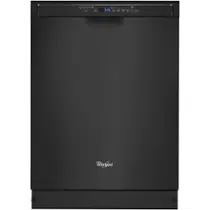Documents: Go to download!
User Manual
- User Manual - (English, French, Spanish)
- Installation Intructions - (English)
- Energy Guide - (English)
- Specification - (English)
- Performance
- Parts and Features
- Quick Steps
- Dishwasher Use
- Cycle and Option Descriptions
- Dishwasher Features
- Filtration System
- Dishwasher Care
- Troubleshooting
Table of contents
Performance
Rinse Aid
Using rinse aid will optimize your drying and wash performance. This dishwasher is specifically designed to be used with rinse aid for improved drying performance and controlling buildup of hard water deposits. Energy efficient dishwashers use less water and energy, so they depend on the water “sheeting” action of rinse aid for total optimal performance
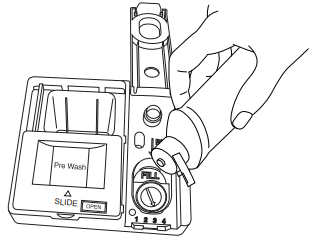
Detergent
The United States and Canada have passed regulations limiting the amount of phosphorus (phosphates) in the household dishwasher detergents to no more than 0.5%, where previous detergents contained 8.7%. Major manufacturers have reformulated their dishwasher detergent for this change in detergents as another step in eco-conscious awareness. With these changes, we recommend quality tablets and packs for convenience and improved performance.

Filtration System
Your dishwasher has the latest technology in dishwasher filtration. This triple filtration system minimizes sound and optimizes water and energy conservation while providing optimal cleaning performance. Maintenance of your filters regularly will sustain peak cleaning performance. We suggest you clean both your upper and lower filters and rinse under running water at least once a month.
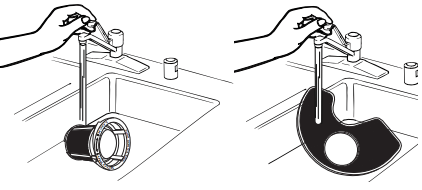
Parts and Features

TOP RACK
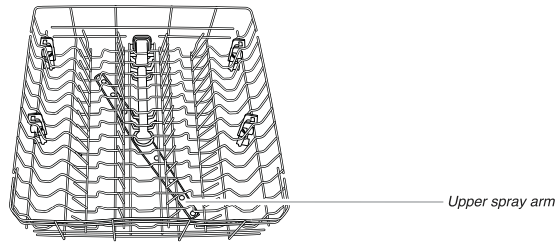
BOTTOM RACK
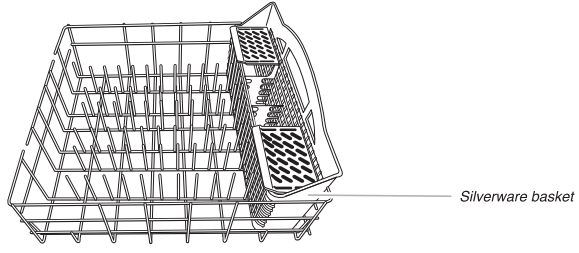
Quick Steps
1. Prepare and load dishwasher.

Spin the spray arms. They should turn freely

2. Add detergent and rinse aid.
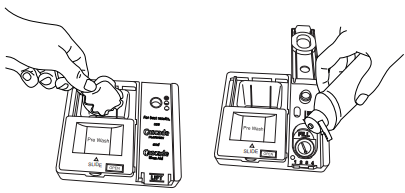
3. Select a cycle and option (cycles and options vary by model)
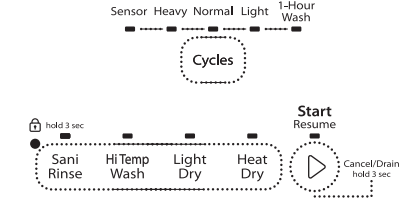
4. Start dishwasher.
Push door firmly closed. Select the wash cycle and options, and then press START/RESUME. To use the same cycle and options used previously, press START/RESUME twice.
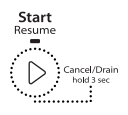
5. Unload dishwasher and clean the filter.
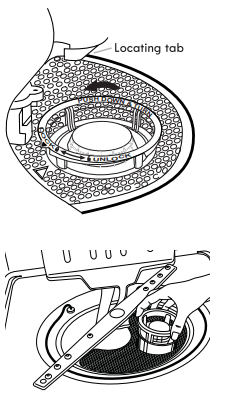
Dishwasher Use
STEP 1
Prepare and Load the Dishwasher
IMPORTANT: Remove leftover food, bones, toothpicks, and other hard items from the dishes. Remove labels from containers before washing.

- Check that when dishwasher door is closed, no items are blocking detergent dispenser.
- Tough soiled items should be loaded with soiled surfaces facing down and inward to the spray. This will improve cleaning and drying results.
- Avoid overlapping items like bowls or plates that may trap food.
- Place plastics, small plates, and glasses in the upper rack. Wash only plastic items marked “dishwasher safe.”
- To avoid thumping/clattering noises during operation, load dishes so they do not touch one another. Make sure lightweight load items are secured in racks.
- When loading silverware, always place sharp items pointing down and avoid “nesting.”
- If your silverware does not fit into the designated slots, flip the covers up and mix silverware types to keep them separated.
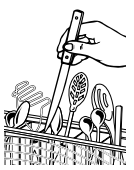
- Use slots in the covers and suggested loading patterns to keep your silverware separated for optimum wash.
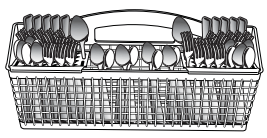
NOTE: Silverware basket may vary by model
- Check that nothing blocks the upper or lower spray arms. Items in rack can block the spray arms.
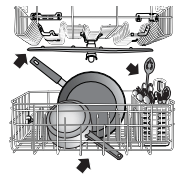
STEP 2
Add Detergent
Premeasured Detergents
High quality premeasured tablets and packs are recommended for improved performance.
Quality tablets and packs have been proven better than powder, liquid, or gel detergents at reducing filming on dishes. Using tablets and packs over time will start to reduce or eliminate white film. They are suitable for all hardness and soil levels. Also, by using a rinse aid, you can minimize repeat buildup of white film (not all packs and tablets contain rinse aid). Always place premeasured detergents in main compartment and slide lid closed.
NOTE: Follow instructions on the package when using other dishwasher detergent types. See the complete owners manual for more details about powders, liquids, and gels.
- Use automatic dishwasher detergent only. Add detergent just before starting a cycle.
- Fresh automatic dishwasher detergent results in better cleaning. Store tightly closed detergent container in a cool, dry place.
To close lid
Place selected detergent in the dispenser. Place finger, as shown, and slide lid closed. Press firmly until it clicks.

To open lid
Push OPEN, as shown, and the lid will slide open.

Powders and Gels
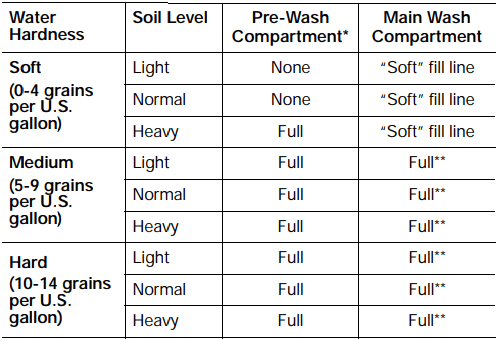
*The prewash compartment is on top of the sliding door of the dispenser.
**A full main wash compartment contains 2 Tbsp. (30 ml).
IMPORTANT: Extremely hard water mineral deposits (15 grains per U.S. gallon or more) can cause damage to your dishwasher and make it difficult to achieve good results. A water softener is recommended to avoid damage and achieve good results.
NOTE: Follow instructions on the package when using other dishwasher detergent types.
STEP 3
Rinse Aid

IMPORTANT: Your dishwasher is designed to use rinse aid. The use of rinse aids greatly improves drying by allowing water to drain from the dishes after the final rinse. Rinse aid also keeps water from forming droplets that can dry as spots or streaks.
Filling the dispenser
The dispenser holds 5 oz (150 mL) of rinse aid. Under most conditions, this will last 1 to 3 months.

NOTE: Indicator reads correct fill level when door is completely opened.
1. To add rinse aid, open the rinse dispenser lid by gently pushing in the center of the lid with your thumb and pulling up on the edge.
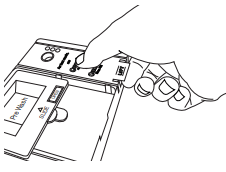
2. Pour rinse aid into the opening until the dispenser is full. Do not overfill.
3. Clean up any spilled rinse aid. Spilled rinse aid can create excessive suds.
4. Then, close the dispenser by pushing down gently on the lid.
To add rinse aid: Open the rinse dispenser lid by gently pushing in the center of the lid with your thumb and pulling up on the edge. Pour rinse aid into the opening until the dispenser is full. Then, close the dispenser by pushing down gently on the lid.
NOTE: For most water conditions, the factory setting will give good results.
Rinse Aid Setting
Your rinse aid dispenser is adjustable. For most water conditions, the factory setting will give good results. If you have hard water and notice calcium buildup on your dishware, you may want to try a higher setting. If you notice foam in your dishwasher, use a lower setting.
To adjust the setting:
Turn the arrow adjuster to a higher number to increase the amount of rinse aid.
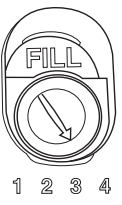
STEP 4
Select a Cycle (varies by model)
Heavier cycles and options affect cycle length.
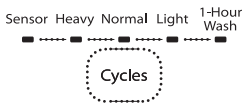
Select Options (varies by model)
You can customize your cycles by pressing the options desired.

STEP 5
Start or Resume a Cycle
- Run hot water at the sink nearest your dishwasher until the water is hot. Turn off water.
- For best dishwashing results, water should be 120ºF (49ºC) as it enters the dishwasher.
- Push door firmly closed. Select the wash cycle and options desired. Press START/RESUME to start the dishwasher.
NOTE: To repeat the same cycle and options used previously, press START/RESUME twice.

- You can add an item anytime at the beginning of the cycle. Open the door slowly and add the item. Close the door firmly. Press START/RESUME.
Cycle and Option Descriptions

Estimated cycle times may increase or decrease depending on water temperature, soil conditions, dish load size, and options selected. You can customize your cycle by selecting an option.
See option selections. If you change your mind, press the option again to turn off the option or select a different option. You can change an option anytime before the selected option begins. At each stage of a wash cycle, you may hear noises that you are not used to hearing in your previous dishwasher. Each cycle will provide a series of pauses and water sprays throughout the wash cycle. This is normal and will provide optimal cleaning performance.
CYCLE SELECTIONS
| CYCLES | SOIL LEVEL | ESTIMATED WASH TIME DISPLAYED* H:MM W/O OPTIONS | ATER USAGE GALLONS (LITERS) | |
 | The most advanced and versatile cycle. This cycle senses load size, soil amount, and toughness of soil, to adjust the cycle for improved performance, using only the amount of water and energy needed. Use for all soil levels. | All soil levels | 2:30 | 3.38 to 7.4 (12.8 to 28.0) |
 | Use for hard-to-clean, heavily soiled pots, pans, casseroles, and tableware. | Heavy | 3:23 | 7.4 (28.0) |
 | This cycle with only the Heat Dry option selected, and without other options selected, is recommended to completely wash and dry a full load of normally soiled dishes. The energy usage label is based on this cycle and option combination. | All soil levels | 2:21 | 2.4 to 7.4 (9.09 to 28.0) |
 | Use for lightly soiled items. It saves energy. | Light | 2:21 | 2.72 (10.29) |
 | For fast results, 1-Hour Wash will clean dishes using slightly more water and energy. For improved drying, select the Heat Dry option. NOTE: Some detergents are not recommended for short wash cycles. Please refer to your detergent packaging for more information. | Light | 1:00 | 7.87 (29.8) |
IMPORTANT: The sensor in your dishwasher monitors the soil level. Cycle time and/or water usage can vary as the sensor adjusts the cycle for the best wash performance. If the incoming water is less than the recommended temperature or food soils are heavy, the cycle will automatically compensate by adding time, heat, and water as needed.
OPTION SELECTIONS
| OPTIONS | CAN BE SELECTED WITH | WHAT IT DOES | ADDED TIME TO CYCLE | ADDED TIME TO CYCLE | |
 | Delay displays how many hours before the cycle will begin. To delay the start: 1. Select a wash cycle and options. 2. Press the Delay button. Each time you press DELAY, it will display the next available delay time. 3. Press START to begin the delay countdown. | Available with any cycle | Delays start of a cycle up to 24 hours. | ||
| NOTE: If the door is opened, such as to add a dish, the Start button must be pressed to resume the delay countdown | |||||
 | Sanitizes dishes and glassware in accordance with NSF International NSF/ANSI Standard 184 for Residential Dishwashers. Certified residential dishwashers are not intended for licensed food establishments. Only sanitizing cycles have been designed to meet the requirements of the NSF/ANSI 184 performance standard for soil removal and sanitization efficacy. There is no intention, either directly or indirectly, that all cycles on a NSF/ANSI 184 certified dishwasher meet the NSF/ANSI 184 performance standard for soil removal and sanitization efficacy. Sani Rinse indicator is lit at the end of the cycle if the Sani Rinse option was successfully completed. If indicator does not light, it is probably due to the cycle being interrupted. | Sensor Heavy Normal | Raises the main wash temperature to 135°F (57°C) and the final rinse temperature to 156°F (69°C). | 0:05 to 1:06 | 0 to 3.9 (0 to 14.6) |
 | Raises water temperature to improve cleaning for loads containing tough, baked-on food. | Sensor Heavy Normal | Raises the main wash temperature to 135°F (57°C). | 0:05 to 0:13 | 0 to 3.9 (0 to 14.6) |
 | Turns the heating element on at the end of the wash portion of the cycle. Its shorter heating time uses significantly less energy compared to using Heat Dry | Available with any cycle | 0:11 | 0 | |
 | Dries dishes with heat. This option, with the use of rinse aid, will provide the best drying results. Plastic items are less likely to deform when loaded in the top rack. Use Heat Dry for optimum drying performance or turn the Heat Dry option off for air dry. | Sensor Heavy Normal 1-Hour Wash | Uses a heating element to speed drying times. Heat Dry option defaults to ON when any cycle is selected except for 1-Hour Wash and Light. | 0:08 to 0:46 | 0 |
Control Lock
| Use the Control Lock option to avoid unintended use of dishwasher between cycles, or cycle and option changes during a cycle. To turn on Control Lock, press and hold SANI RINSE for 3 seconds. Control Lock light will stay on for a short time, indicating that it is activated. When the Lock indicator is lit, all buttons are disabled. If you press any button while your dishwasher is locked, the light flashes 3 times. The dishwasher door can still be opened/closed while the controls are locked. To turn off Control Lock, press and hold SANI RINSE for 3 seconds. Control Lock light turns off. | ||||
CONTROLS AND CYCLE STATUS
| CONTROL | PURPOSE | COMMENTS |
 | Press to start or resume a wash cycle. If the door is opened during a cycle or the power is interrupted, the Start/Resume button LED flashes. Cycle will not resume until door is closed and Start/Resume is pressed. Press to cancel wash cycle. Close the door firmly. Press and hold START/RESUME or 3 seconds. The dishwasher starts a 2-minute drain (if needed). Let dishwasher drain completely | |
 | To follow progress of your dishwasher cycle. NOTE: Indicators shown are not available on all models. | The Clean indicator glows when a cycle is finished. If you select the Sani Rinse option, when the cycle is finished, the “Sanitized” indicator glows. If your dishwasher did not properly sanitize your dishes, the light flashes at the end of the cycle. This can happen if the cycle is interrupted, or water could not be heated to required temperature. The light goes off when you open and close door or when you cancel the cycle. |
Dishwasher Features
Removable Top Rack
The removable top rack allows you to wash larger items such as pots, roasters, and cookie sheets in the bottom rack.
IMPORTANT: Remove dishes prior to removing the top rack from dishwasher.
To remove the rack
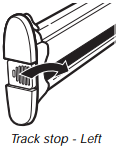
1. To gain access to the track stops, pull the upper rack forward about halfway out of the tub.
2. Press on the edge of the ridged area on the track stop while tipping the track stop toward the center of the dishwasher. This action releases a small retaining tab that locks the track stop to the track.
NOTE: It is helpful to use two hands. Take special note of the orientation of the track stops
3. With the retaining tab released, pull the track stop straight toward the opposite track to remove it.
4. After removing both track stops, carefully pull the top rack out of the tracks by rolling it toward you.
5. Replace the track stops by coming up from under the track and slipping the track stop into the lower slot of the track and rotate the track stop into place. Then press on the edge of the ridged area while pushing the track stop straight toward the track. This action locks the retaining tab back into place.
6. Test the track stop by pulling it toward the opposite track to ensure that it is locked in place.
To replace the rack

1. Gently pull the tracks forward in dishwasher until they stop. Remove track stops. (See steps 1-3 above.)
2. Place the back wheels on each side of the rack into the track and roll the rack into the tracks, but do not push the rack all the way into the tub.
3. Insert front rack wheels on each side of the rack into the track.
4. Slide the rack into the dishwasher.
5. Replace the track stops by coming up from under the track and slipping the track stop into the lower slot of the track and rotate the track stop into place. Then press on the edge of the ridged area while pushing the track stop straight toward the track. This action locks the retaining tab back into place.
6. Test the track stop by pulling it toward the opposite track to ensure that it is locked in place.
IMPORTANT: Be sure that the track stops are locked in place and cannot be easily removed. They keep the rack from coming out of the track.
Filtration System
Your dishwasher has the latest technology in dishwasher filtration. This triple filtration system minimizes sound and optimizes water and energy conservation while providing superior cleaning performance. Throughout the life of your dishwasher, the filter will require maintenance to sustain peak cleaning performance.
The triple filter system consists of 2 parts, an upper filter assembly and a lower filter.
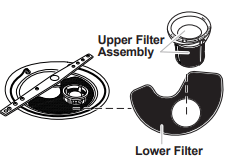
- The upper filter assembly keeps oversized items and foreign objects, along with very fine food particles, out of the pump.
- The lower filter keeps food from being recirculated onto your dishware. The filters may need to be cleaned when:
- Visible object or soils are on the Upper Filter Assembly.
- There is degradation in cleaning performance (that is, soils still present on dishes).
- Dishes feel gritty to the touch.
It is very easy to remove and maintain the filters. The chart below shows the recommended cleaning frequency
RECOMMENDED TIME INTERVAL TO CLEAN YOUR FILTER
| Number of Loads Per Week | If you only scrape before loading* | If you scrape and rinse before loading | If you wash before loading |
| 8-12 | Every 2 months | Every 4 months | Once per year |
| 4-7 | Every 4 months | Once per year | Once per year |
| 1-3 | Twice per year | Once per year | Once per year |
*We recommend this practice because it will conserve the water and energy that you would have used to prepare your dishes. This will also save you time and effort.
Very Hard Water
If you have hard water (above 15 grains), clean your filter at least once per month. Buildup of white residue on your dishwasher indicates hard water. For tips on removing spots and stains, see “Troubleshooting” section.
Filter Removal Instructions
1. Turn the Upper Filter Assembly ¼ turn counterclockwise and lift out.
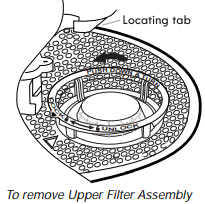
2. Separate the upper filter assembly by gently pulling apart.
3. Clean the filters as shown.

Cleaning Instructions
IMPORTANT: Do not use wire brush, scouring pad, etc., as they may damage the filters. Rinse filter under running water until most soils are removed. If you have hard-to-remove soils or calcium deposits from hard water, a soft brush may be required.
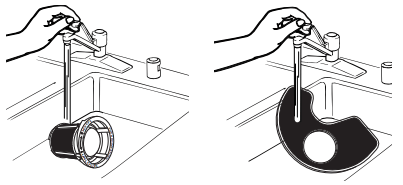
Filter Reinstallation Instructions
1. Noting the previous illustrations, place the Lower Filter under the Locating Tabs in the bottom of the dishwasher so the round opening for the Upper Filter Assembly lines up with the round opening in the bottom of the tub.
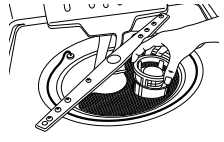
2. Insert the Upper Filter Assembly into the circular opening in the Lower Filter
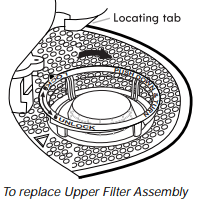
3. Slowly rotate the filter clockwise until it drops into place. Continue to rotate until the filter is locked into place. If the filter is not fully seated (still turns freely), continue to turn the filter clockwise until it drops and locks into place.
NOTE: The Upper Filter Assembly arrow does not have to align with the arrow in the Lower Filter as long as the filter is locked.
IMPORTANT: To avoid damage to dishwasher, do not operate your dishwasher without the filters properly installed. Be sure the Lower Filter is securely in place and the Upper Filter Assembly is locked into place. If the Upper Filter Assembly turns freely, it is not locked into place.
Dishwasher Care
CLEANING THE DISHWASHER
Cleaning the Exterior
Clean the exterior of dishwasher with a soft, damp cloth and mild detergent. If your dishwasher has a stainless steel exterior, a stainless steel cleaner is recommended, such as affresh® Stainless Steel Cleaner. Avoid using abrasive cleaning products on the exterior of the dishwasher.
Cleaning the interior
Clean the interior of the dishwasher with a paste of powdered dishwasher detergent and water or use liquid dishwasher detergent on a damp sponge to clean the cooled-down interior.
A white vinegar rinse may remove white spots and film. Vinegar is an acid and using it too often could damage your dishwasher.
Put 2 cups (500 mL) white vinegar in a glass or dishwasher-safe measuring cup on the bottom rack. Run the dishwasher through a complete washing cycle using an air-dry or an energy-saving dry option. Do not use detergent. Vinegar will mix with the wash water
Dishwasher maintenance procedure
Removal of Hard Water/Filming
Recommended use of a monthly maintenance product such as affresh® Dishwasher Cleaner.
- Place affresh® Dishwasher Cleaner tablet in main wash compartment of detergent dispenser.
- Select a normal cycle and start the dishwasher.
NOTE: Whirlpool recommends the use of premeasured detergent tablets or packs and the use of rinse aid for regular daily use.
Drain air gap
If you have a drain air gap, check and clean it if the dishwasher isn't draining well.
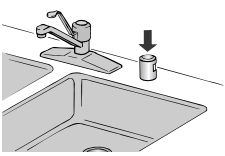
To reduce risk of property damage during vacation or extended time without use
- When you will not be using the dishwasher during the summer months, turn off the water and power supply to the dishwasher.
- Make sure the water supply lines are protected against freezing conditions. Ice formations in the supply lines can increase water pressure and cause damage to your dishwasher or home. Damage from freezing is not covered by the warranty.
- When storing your dishwasher in the winter, avoid water damage by having your dishwasher winterized by authorized service personnel.
Troubleshooting
| PROBLEM | SOLUTION |
| DISHWASHER DOES NOT RUN | NOTE: It is normal for the dishwasher to repeatedly pause several times during a cycle. If the Start/Resume light is blinking, close the door and push START/RESUME. Be sure the door is closed and latched. Be sure you have disabled Sleep mode by pressing either Start/Resume or Cancel, or opening and closing the door before selecting your cycle/option. Check that there is not an interference with large casserole dishes and the wash system at the back of the dishwasher. Check to see if any items are protruding through the bottom or back of the rack. Also check to see if tall items are hitting the upper rack or spray arm. Adjust loading as necessary to ensure door is closed and latched. Be sure you have selected a cycle. See “Cycle and Option Descriptions” section. Be sure there is power to the dishwasher. A circuit breaker or fuse may have tripped. If lights other than Start/Resume blink and the unit will not run, you will need to call for service. |
| DETERGENT REMAINS IN THE DISPENSER OR TABLET IS ON BOTTOM OF TUB | Check for dishware such as cookie sheets, cutting boards, or large containers, etc., that may be blocking the detergent dispenser from opening properly. Be sure your detergent is fresh and lump free. Be sure the cycle has completed (the Clean light is on). If it has not completed, you will need to resume the cycle by closing the door and pressing Start/Resume. |
| CYCLE RUNS TOO LONG | NOTES: To use less water and reduce energy consumption, you will encounter cycles that typically run for up to 3 hours. A water heater setting of 120°F (49°C) is best. The dishwasher will delay longer while heating cooler water. Some options will add time to the cycle. See “Cycle and Option Descriptions” section. The Heat Dry option adds approximately 45 minutes. Try the 1 Hour Wash cycle. Run the hot water at a faucet close to the dishwasher before starting the cycle. |
| DISHWASHER NOT DRYING | NOTE: Plastic and items with nonstick surfaces are difficult to dry because they have a porous surfaces which tend to collect water droplets. Towel drying may be necessary. Use of rinse aid along with the Heat Dry option is needed for proper drying. Proper loading of items can affect drying. (See specific loading instructions within this guide.) Glasses and cups with concave bottoms hold water. This water may spill onto other items when unloading. Unload the bottom rack first. Locate these items on the more slanted side of the rack for improved results |
| WILL NOT FILL | Be sure the water is turned on to the dishwasher. Check that the overfill protection float is free from obstructions. See “Parts and Features” section. Check for suds in the dishwasher. If foam or suds are detected, the dishwasher may not operate properly or may not fill with water. See “Blinking Lights” in “Troubleshooting” section. |
| WATER REMAINS IN THE TUB/WILL NOT DRAIN | Be sure the cycle has completed (the Clean indicator is on). If it has not, you will need to resume the cycle by closing the door and pressing Start/Resume. If dishwasher is connected to a food waste disposer, be sure the knockout plug has been removed from the disposer inlet. Check for kinks in the drain hose. Check for food obstructions in the drain or disposer. Check your house fuse or circuit breaker |
| HARD WATER (WHITE RESIDUE ON DISHWASHER INTERIOR OR GLASSWARE) | NOTE: Extremely hard water mineral deposits can cause damage to your dishwasher and make it difficult to achieve good cleaning. A water softener is strongly recommended if your hardness is 15 grains or more. If a water softener is not installed, the following steps may help: Use a commercial cleaner designed for dishwashers once per month. Clean the upper and lower filters at least once per month. See “Cleaning Instructions” in the “Filtration System” section. Always use a rinse aid. Always use a high-quality, fresh detergent. Use a detergent booster/water softener additive designed for dishwashers |
| ODORS | NOTE: If the dishwasher is not used daily, you can run a rinse cycle with the partial load until a full load is ready to run. Run a vinegar rinse through the dishwasher by putting 2 cups (500 mL) of white vinegar in an upright glass measuring cup in the lower rack. Run a normal cycle with the Heat Dry option turned off. Do not use detergent. The dishwasher may not be draining properly, see “Water Remains In The Tub/Will Not Drain” in the “Troubleshooting” section. |
| NOISY | NOTES: Surging sounds can occur periodically throughout the cycle while the dishwasher is draining. Normal water valve hissing may be heard periodically. A normal snap sound may be heard when the detergent dispenser opens during the cycle and when the door is opened at the end of the cycle. Improper installation will affect noise levels. Be sure the filters are properly installed. A thumping sound may be heard if items extend beyond the racks and interfere with the wash arms. Readjust the dishware and resume the cycle. |
| FOOD SOILS REMAIN ON DISHES | Be sure the dishwasher is loaded correctly. Improper loading can greatly decrease the washing performance. See “Dishwasher Use” section. Check filter to ensure it is properly installed. Clean it if needed. See “Cleaning Instructions” in the “Filtration System” section for details. Select the proper cycle and option for the type of soils. The Sensor or Heavy cycle with the Hi Temp Wash option can be used for tougher loads. Be sure the incoming water temperature is at least 120°F (49°C). Use the proper amount of fresh detergent. More detergent is needed for heavier soiled loads and hard water conditions. Scrape food from dishes prior to loading (do not prerinse) |
| DISHES DIRTY/SUDS IN DISHWASHER/CYCLE NOT COMPLETE | If foam or suds are detected by the dishwasher sensing system, the dishwasher may not operate properly or may not fill with water. Suds can come from: Using the incorrect type of detergent, such as dish detergent for hand washing dishes, laundry detergent, or hand soap. Not replacing the rinse aid dispenser cap after filling (or refilling) the rinse aid. Using an excessive amount of dishwasher detergent. Inadequate rinsing off detergent from dishes washed by hand before loading them into the dishwasher. Call for service. If no water was present in the machine at any time during a heated wash cycle, the cycle will end and the Clean indicator will not come on. See “Will Not Fill” in the “Troubleshooting” section. |
| DID NOT SANITIZE | If the sanitized light is blinking, the load is NOT sanitized. The cycle was interrupted in the final rinse or the temperature for your water heater is set too low. Set your water heater to 120ºF (49°C). |
| DAMAGE TO DISHWARE | Improper loading can cause dishes to become chipped or damaged. (See specific loading instructions within this guide.) |
| BLINKING LIGHTS | Blinking indicators will occur when the cycle is paused or when the cycle has been interrupted by opening the door. In this case, the Start/Resume button LED, the Cycle Status Indicator LED(s), and the countdown bars on the Cycle Status Display all blink together to indicate that attention is needed. See “Start or Resume a Cycle” in the “Dishwasher Use” section. Blinking indicators can also occur when certain errors have been detected. In this case, the Clean indicator will blink 4 times in a row with a pause in between each set of blinks. When this error occurs, the controls will lock out and not allow another cycle to be started. Call for service. |
| CLOUDY OR SPOTTED DISHWARE (AND HARD WATER SOLUTION) | NOTES: Liquid rinse aid is necessary for drying and to reduce spotting. Use the correct amount of detergent. Confirm that the cloudiness is removable by soaking the item in white vinegar for 5 minutes. If the cloudiness disappears, it is due to hard water. Adjust the amount of detergent and rinse aid. See “Hard Water (White Residue On Dishwasher Interior Or Glassware)” in the “Troubleshooting” section. If it does not come clear, it is due to etching (see below). Be sure the incoming water temperature is set at 120°F (49°C). Try using the High Temp Wash and Sani Rinse options. To remove spotting, run a vinegar rinse through the dishwasher. Wash and rinse the affected dishware and load into dishwasher. Remove all silverware and metal items. Put 2 cups (500 mL) of white vinegar in a glass measuring cup in the lower rack. Run a normal cycle with the Heat Dry option turned off. No detergent is needed. |
| ETCHING (PERMANENT CLOUDINESS) | This is an erosion of the surface of the glassware and can be caused by a combination of: water that is too hot, from using too much detergent with soft water, or by prewashing. Detergent needs food soil to act upon. If etching has occurred, the glassware is permanently damaged. To avoid further etching, adjust the detergent amount to match the water hardness, stop prewashing, and use water heating options only when incoming water temperature is below 120°F (49°C) |
| LEAKING WATER | Be sure dishwasher has been installed properly and is level. Suds can cause the dishwasher to overflow. Measure the detergent accurately and use only detergents designed for use in a dishwasher. Less detergent is needed in soft water. Try another brand of detergent if sudsing continues. To avoid rinse aid leaking from the dispenser, be sure the lid is securely attached and avoid overfilling |
| TUB IS DISCOLORED | NOTES: High iron content in the water can discolor the tub. Tomato-based foods can discolor the tub or dishware. Large amounts of tomato-based foods should be removed from the dishes before loading. A citrus-based cleaner can be used to clean. |
See other models: WRB329DFBB WRFA60SFHZ WGD5620HW WUW55X24HS WRSA15SNHN

